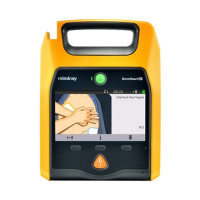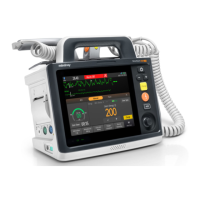Defibrillator/Monitor Operator’s Manual B - 1
B Mindray Shockable Rhythm Analysis Algorithm
The equipment configured with Mindray shockable rhythm analysis algorithm acquires and analyzes the
patient’s ECG signals to determine whether or not to give a defibrillation shock. If a shockable rhythm is
detected, the algorithm recommends a defibrillation shock. If a nonshockable rhythm is detected, the algorithm
recommends no shocks, avoiding unnecessary defibrillation shock to the patient.
Mindray shockable rhythm analysis algorithm has been validated by using the database for evaluation of
Mindray algorithm performance.
B.1 Rhythm Recognition and Annotation Methodology
This section describes the recording method, rhythm source, rhythm selection criteria, annotation methods and
criteria the database for evaluation of Mindray shockable rhythm analysis algorithm.
B.1.1 Database for Evaluation of Mindray Algorithm Performance
The database for evaluation of Mindray algorithm performance includes international standard database and
Mindray clinical database for evaluating the ECG data. The ECG data for evaluation is selected according to AHA
recommendations
a
with a 10-second wave length.
Database for evaluation of Mindray shockable rhythm analysis algorithm includes:
■ MIT-BIH: The Massachusetts Institute of Technology–Beth Israel Hospital Arrhythmia Database (from Holter)
■ AHA: The American Heart Association Database for Evaluation of Ventricular Arrhythmia Detectors (from
Holter)
■ VFDB: MIT-BIH Malignant Ventricular Arrhythmia Database (from Holter)
■ CU: The Creighton University Sustained Ventricular Arrhythmia Database [the third edition] (from hospital
monitor)
■ NST: The Noise Stress Test Database (12 ECG records of 30 minutes each plus 3 records of noise only -
supplied with the MIT–BIH database)
■ Mindray clinical data (from Mindray monitors, defibrillator monitors and automated external defibrillators)
B.1.2 Rhythm Categories
Each rhythm category for evaluating the ECG data has been confirmed by the clinical experts.
■ Shockable rhythms
◆ Coarse ventricular fibrillation (VF): amplitude ≥0.2mV
◆ Rapid ventricular tachycardia (VT): HR≥150bpm, QRS duration ≥120ms
■ Nonshockable rhythms
◆ Normal sinus rhythm
◆ Asystole: amplitude <0.1mV
◆ Atrial fibrillation/flutter, supraventricular tachycardias, sinus bradycardia, idioventricular rhythms,
heart block, premature ventricular contractions, etc
■ Intermediate rhythms
◆ Fine ventricular fibrillation: 0.1mV < amplitude <0.2mV
◆ Other VT: ventricular tachycardia that does not meet criteria for VT in the shockable rhythms category

